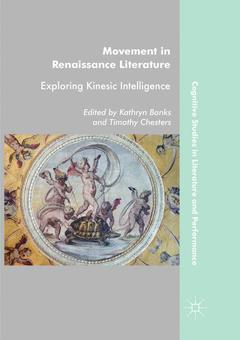Movement in Renaissance Literature, Softcover reprint of the original 1st ed. 2018 Exploring Kinesic Intelligence Cognitive Studies in Literature and Performance Series

This book investigates how writers and readers of Renaissance literature deployed ?kinesic intelligence?, a combination of pre-reflective bodily response and reflective interpretation. Through analyses of authors including Petrarch, Rabelais, and Shakespeare, the book explores how embodied cognition, historical context, and literary style interact to generate and shape responses to texts. It suggests that what was reborn in the Renaissance was partly a critical sense of the capacities and complexities of bodily movement. The linguistic ingenuity of humanism set bodies in motion in complex and paradoxical ways. Writers engaged anew with the embodied grounding of language, prompting readers to deploy sensorimotor attunement. Actors shaped their bodies according to kinesic intelligence molded by theatrical experience and skill, provoking audiences to respond to their most subtle movements. An approach grounded in kinesic intelligence enables us to re-examine metaphor, rhetoric, ethics, gender, and violence. The book will appeal to scholars and students of English, French, and Italian Renaissance literature and to researchers in the cognitive humanities, cognitive sciences, and theatre studies.
.- 1 Introduction.- 2 Chiastic Cognition: Kinesic Intelligence Between the Reflective and the Pre-Reflective in Montaigne and Scève.- 3 Turning Toward the Beloved (Virgil, Petrarch, Scève).- 4 Scève’s Denominal Verbs.- 4 Metaphor, Lexicography, and Rabelais’s Prologue to Gargantua.- 4 The Gunpowder Revolution in Literature: Early Modern Wounds in Folengo and Rabelais.- 6 The Finger in the Eye: Jacques Duval's Traité des Hermaphrodits (1612).- 7 Exchanging Hands in Titus Andronicus.- 8 “Cabin’d, Cribb’ed, Confin’d”: Images of Thwarted Motion in Macbeth.- 9 Shakespeare’s Vital Signs.- 10 Kinesic Intelligence on the Early Modern English Stage.- 11 Afterword: How Do Audiences Act?.
Kathryn Banks is Associate Professor of French at Durham University, UK. She is the author of Cosmos and Image in the Renaissance (2008) and has published essays on Rabelais, sixteenth-century poets, apocalyptic writing, Chrétien de Troyes, and cognitive approaches to literature. She was awarded a Philip Leverhulme Prize in 2013.
Timothy Chesters is University Lecturer in Sixteenth-Century French Studies and a Fellow of Clare College, Cambridge, UK. He is the author of Ghost Stories in Late Renaissance France: Walking by Night (2011). He has also published on Rabelais, Ronsard, Montaigne, and Flaubert, and on cognitive approaches to literature.
Pioneers a rich new scholarly approach of applying kensic intelligence theories to Renaissance texts
Presents a range of Renaissance writers and thinkers including Shakespeare, Montaigne, and Scève
Utilizes theories of psychology, philosophy, neuroscience, and literary analysis
Date de parution : 06-2019
Ouvrage de 249 p.
14.8x21 cm
Disponible chez l'éditeur (délai d'approvisionnement : 15 jours).
Prix indicatif 84,39 €
Ajouter au panierDate de parution : 01-2018
Ouvrage de 249 p.
14.8x21 cm
Disponible chez l'éditeur (délai d'approvisionnement : 15 jours).
Prix indicatif 116,04 €
Ajouter au panierThèmes de Movement in Renaissance Literature :
Mots-clés :
Kinesic intelligence; embodied cognition and Renaissance Literature; "To His Coy Mistress"; Montaigne's Essais I.26; reflective and pre-reflective cognition; Scève’s Délie; Cognition in Early Modern French Literature; neroscience and lexicography; early modern warfare and kinesics; Jacques Duval’s Traité des hermaphrodits; kinesics of early modern erotic writing; handshakes in Shakespeare's Titus Andronicus; bodily confinement and Shakespeare's Macbeth; Sensorimotor response in Shakesepare's plays; kinesics o



